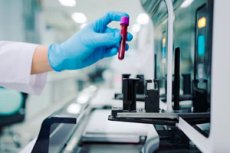New publications
New blood test tracks brain recovery after concussion
Last reviewed: 02.07.2025

All iLive content is medically reviewed or fact checked to ensure as much factual accuracy as possible.
We have strict sourcing guidelines and only link to reputable media sites, academic research institutions and, whenever possible, medically peer reviewed studies. Note that the numbers in parentheses ([1], [2], etc.) are clickable links to these studies.
If you feel that any of our content is inaccurate, out-of-date, or otherwise questionable, please select it and press Ctrl + Enter.

A blood test can accurately identify the ongoing effects of sport-related concussion and help determine when it is safe to return to training, a Monash University-led study has found.
The researchers measured levels of two brain-specific proteins in the blood of 81 Victorian Amateur Football Association (VAFA) players who had suffered concussion and compared them with 56 players who had not suffered concussion.
By tracking blood biomarker levels over time, they monitored how long it took for players' brains to recover, otherwise known as "neurobiological recovery," to help determine when it might be safe to return to play without increased risk of injury.
Until now, there have been no well-established tools to track neurobiological recovery after sports-induced concussion.
Published in JAMA Network Open, this cohort study examined the dynamics of two brain cell proteins, glial fibrillary acidic protein (GFAP) and neurofilament light protein (NfL), that are released into the blood following brain injury.
While the team's previous research has demonstrated the diagnostic potential of these biomarkers in the blood, this study aimed to show how their levels changed over time in concussed players.
The most striking finding was the diversity of biomarker changes across individuals: more than 20% of concussions showed significant and sustained increases in both GFAP and NfL, which remained elevated compared to uninjured football players for more than four weeks.
People with these extreme biomarker changes were significantly more likely to lose consciousness following a head impact.
Study leader and principal investigator of the Monash Trauma Group, Dr Stuart McDonald, from Monash University's School of Translational Medicine, said that while his team and others had investigated these biomarkers previously, this was the first time a full profile of progression following injury had been recorded.
"What's unique about this study is not the measurement itself, but how many times and how consistently we did it - eight times over six months across 137 athletes," said Dr McDonald. "With very little missing data, due to our unique approach of visiting participants at home, we were able to get a detailed profile of biomarker trajectories over time.
"We have demonstrated that blood GFAP levels are elevated in the vast majority of concussed athletes after 24 hours, and we are now working to get this much-needed diagnostic test approved for use in the coming years.
"The next important step is to demonstrate how and when we should measure these two proteins as biomarkers for return to play. Our findings bring us closer to making this a reality.
"Our vision is for serial measurements of these proteins to be integrated into clinical practice, guiding return-to-play decisions based on both symptoms and neurobiological recovery."
